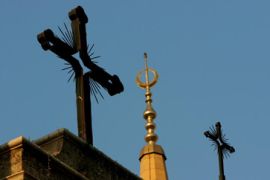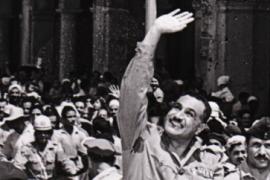Lebanon’s first civil conflict
The growth of Nasser’s pan-Arab popularity increased tensions in volatile Lebanon.

 |
| In 1982, US Marines landed on Lebanese beaches, repeating a similar engagement in 1958. The US would continue to be involved in Lebanese politics well into 2008 [GALLO/GETTY] |
Viewed as the intellectual and commercial capital of the Arab world – a unique blend of the West and the Middle East, of Christendom and Islam – Lebanon was a magnet for money, democracy and political refugees.
But in the late 1950s, the rise of Gamal Abdel Nasser in Egypt and the upsurge of Arab nationalism put Lebanon’s democratic system under severe strain.
The struggle for power between Lebanon’s pro-Arabist opposition and its president was also exacerbated by the unification of Syria and Egypt into a federation called the United Arab Republic (UAR) in February 1958.
By raising the issue of Arab unity, Egypt’s Nasser seriously threatened the critical balance of power in Lebanon achieved by the Maronites, Druze and Sunnis since its independence in 1943.
Large sections of Lebanese Christians saw in this development a threat to the independent existence of the State of Lebanon and to their prominent role in government and society.
Adel Osseiran, the Muslim Lebanese speaker of parliament, declared in 1958 that “Lebanon will march with the Arab caravan” and that “anyone who thinks of working for interests other than those of the Arabs will have no room in Lebanon”.
Chamoun reacts
 |
| Nasser’s political victory in the Suez Crisis reverberated in Lebanon |
But this angered Camille Chamoun, Lebanon’s president and a staunch Maronite, who became increasingly intolerant of the Muslim opposition.
Chamoun had taken office the same year Nasser came to power in 1952. By the middle of his six-year term, Chamoun’s extreme pro-Westernism and Nasser’s burgeoning Arab nationalism were locked in battle.
To the dismay of both the Muslims and Lebanese nationalists, the Lebanese president refused to sever diplomatic ties with Britain and France after they – and Israel – attacked Egypt in 1956.
“The rulers of Lebanon,” Nasser declared later, “stabbed us in the back during our time of stress.”
Disregarding Muslim sensitivities, Chamoun went a step further and placed Lebanon under the Eisenhower Doctrine, the American pledge to defend friendly governments against outside ‘communist’ threats.
While Chamoun and his government were determined to win the battle of wills against the opposition by counting on the physical and political support of the Western powers, they overestimated Lebanon’s strategic importance to the West.
Suez aftershock
|
Related |
The unrest was intensified by the assassination of Nassib Matni, the Maronite anti-Chamoun editor of Al Telegraph, a daily newspaper known for its outspoken pan-Arabism. The revolt almost became a religious conflict between Christians and Muslims.
In the early hours of July 14, 1958, a revolution overthrew the monarchy in Iraq and the entire royal family was killed. Lebanon found itself caught in the trap of politics and national agendas of its more powerful neighbours as it would increasingly in the future.
In Lebanon, jubilation prevailed in areas where anti-Chamoun sentiment predominated, with radio stations announcing that the Chamoun regime would be next.
Realising the gravity of his situation, he summoned the ambassadors of the US, Britain and France on the morning of July 14 and argued that Lebanese Muslims were being helped by Syria which had received arms from the Soviet Union.
Fawaz Gerges, a professor of Middle East studies at Sarah Lawrence College in New York, says Chamoun may have overplayed his international significance.
“The Lebanese crisis might not have escalated so dangerously had Chamoun’s regime and its opponents not over-estimated their strategic importance,” Gerges told Al Jazeera.
“If both sides had kept a proper perspective of their place in the world, they would have been forced to come to terms with each other. Instead, they relied on foreign intervention to tilt the balance of power in their favour.”
“They lost sight of the fact that the external actors were using them as proxies to fight their own wars,” Gerges added.
Marines land
|
A Question of Arab Unity Web special coverage |
|
Revolution Calling Rising Nationalism 1948: A Cause for Arab Unity? |
The first American marine contingent landed in Beirut on July 15, 1958. The operation was swift, clean and successful. The civil strife came to an end on July 31 with both sides accepting Lebanese army commander General Fuad Chehab as the next president of Lebanon.
Although the war took a toll of some 2,000 to 4,000 lives, it was regarded by many as a comic opera, especially when 5,000 US Marines landed on the beaches near Beirut and waded ashore among sunbathers and swimmers.
The 1958 ‘civil war’, says Nadim Shehadi, an associate fellow at London’s Chatham House, came as an aftershock of the 1956 Suez War “in the same way as the 1969 crisis came as an aftershock of the 1967 war and the civil war came two years after the 1973 war”.
“In the aftermath of the Iraqi revolution and US intervention in Lebanon, the Eisenhower administration embarked on a major reappraisal of its strategy in the area,” Gerges told Al Jazeera.
“To the United States, the virtual collapse of conservative resistance to radical Arab nationalism made the latter appear to be the driving force in the region; it was the wave of the future.”